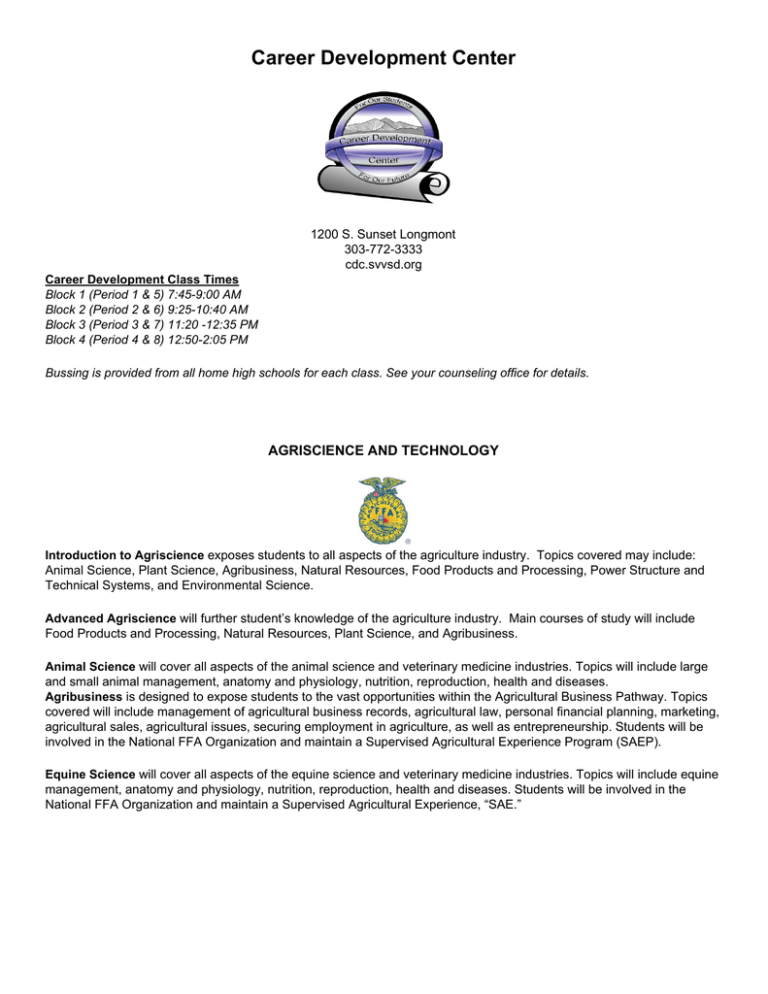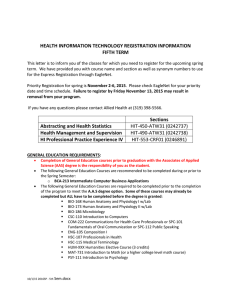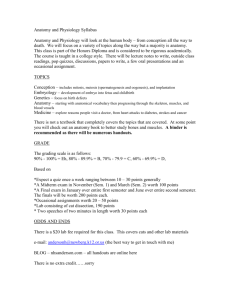Career Development Center
advertisement

Career Development Center 1200 S. Sunset Longmont 303­772­3333 cdc.svvsd.org Career Development Class Times Block 1 (Period 1 & 5) 7:45­9:00 AM Block 2 (Period 2 & 6) 9:25­10:40 AM Block 3 (Period 3 & 7) 11:20 ­12:35 PM Block 4 (Period 4 & 8) 12:50­2:05 PM Bussing is provided from all home high schools for each class. See your counseling office for details. AGRISCIENCE AND TECHNOLOGY C IE C N Introduction to Agriscience exposes students to all aspects of the agriculture industry. Topics covered may include: Animal Science, Plant Science, Agribusiness, Natural Resources, Food Products and Processing, Power Structure and Technical Systems, and Environmental Science. Advanced Agriscience will further student’s knowledge of the agriculture industry. Main courses of study will include Food Products and Processing, Natural Resources, Plant Science, and Agribusiness. Animal Science will cover all aspects of the animal science and veterinary medicine industries. Topics will include large and small animal management, anatomy and physiology, nutrition, reproduction, health and diseases. Agribusiness is designed to expose students to the vast opportunities within the Agricultural Business Pathway. Topics covered will include management of agricultural business records, agricultural law, personal financial planning, marketing, agricultural sales, agricultural issues, securing employment in agriculture, as well as entrepreneurship. Students will be involved in the National FFA Organization and maintain a Supervised Agricultural Experience Program (SAEP). Equine Science will cover all aspects of the equine science and veterinary medicine industries. Topics will include equine management, anatomy and physiology, nutrition, reproduction, health and diseases. Students will be involved in the National FFA Organization and maintain a Supervised Agricultural Experience, “SAE.” AUTOMOTIVE TECHNOLOGY Automotive Maintenance and Light Repair for Female Students I–Beginning Automotive Technology (Semester One) This year long program contains two different classes that are specifically designed for female students who would enjoy a single gender class. The first class covers automotive industry standards and terminology, career opportunities and classifications, shop operations and safety, tool identification and usage, diagnostic equipment identification and usage, automotive systems, tires and wheels, hydraulic braking systems, cooling systems, lubrication systems and preventative maintenance. ( This is a YEAR ONE CLASS.) Automotive Maintenance and Light Repair for Female students II­­Basic electrical (Semester Two) The second half of the Automotive Maintenance and Light Repair Class for Female students teaches the basics of electrical systems, electronic systems, batteries, starting systems, charging systems, lighting systems, electrical instruments and accessories, and ignition systems. This class teaches students to troubleshoot common problems and to diagnose typical repairs. ( This is a YEAR ONE CLASS.) Beginning Auto Beginning Auto Technology covers automotive industry standards and terminology, career opportunities and classifications, shop operations and safety, tool identification and usage, diagnostic equipment identification and usage, automotive systems, tires and wheels, hydraulic braking systems, cooling systems, lubrication systems, and preventative maintenance. Also included is basic operation of automotive braking systems­­operation, diagnosis and basic repair of disc, drum, and basic hydraulic braking systems. Focuses on lecture and related experiences in the diagnosis and service of suspensions and steering systems and their components. ( This is a YEAR ONE CLASS and a prerequisite to all advanced classes.) Basic Electrical teaches the basics of electrical systems, electronic systems, batteries, starting systems, charging systems, lighting systems, electrical instruments and accessories, and ignition systems. ( This is a YEAR ONE OR TWO CLASS­­may be taken after Beginning Auto.) Brake Systems This course covers operation, diagnosis, service and repair of drum, disc, basic hydraulic, anti­lock, power assist units and machine operations of today’s automobile brake systems. This class also teaches skills to perform service checks and procedures to automotive foundation braking systems and identify components and types of Anti Lock Braking Systems “ABS” as well as traction control systems. ( This is a YEAR ONE OR TWO CLASS­­may be taken after Beginning Auto.) Suspension and Alignment Covers: design, diagnosis, inspection, and service suspension and steering systems used on light trucks and automobiles. Course includes power steering, Supplemental Restraint System “SRS” (or airbags) and all alignment procedures on industry standard equipment is covered in this class. (T his is a YEAR ONE OR TWO CLASS­­may be taken after Beginning Auto.) Engine Performance Areas of instruction include intake and exhaust systems, ignition system diagnosis and service, fuel system diagnosis and service, carburetor diagnosis and service, fuel injection diagnosis and service, emission control diagnosis and service, and on­board diagnostic system and service. ( This is a YEAR THREE CLASS.) Engine Repair Instruction combines lecture and laboratory experiences in the removal and installation of the automotive engine, transmission, transfer case, and clutch assembly from and into front and rear wheel drive vehicles. ( This is a YEAR THREE CLASS.) COSMETOLOGY COSMETOLOGY Hairstyling 1 and 2 This 2 year program includes haircutting, hairstyling, hair­color treatment, conditioning and scalp treatment, permanent waving and straightening, and dressing wigs. All students enrolled in the program must successfully complete a minimum of 1200 hours of training to take the State Board examination to be a licensed hairstylist. C lasses are ½ day long for two years . CULINARY ARTS Culinary Arts/Chef Training I & II teach the basic skills of food production for a commercial kitchen, restaurant, or catering facility. Skill areas will include safety and sanitation, nutrition, menu planning, baking, production of desserts, entrees, soups, sauces, salads, and sandwiches. Students are rotated through production and service stations, while serving the community. Students learn guest relations as well as, how to keep accurate financial records for the profit and loss of the operation. Baking and Pastry In addition to reviewing and continued practice of safety and sanitation procedures, students will be introduced to the topics of basic baking terminology and measurement, baking percentages and ratios, ingredients, quick bread/yeast/lamination dough, cakes and petite fours, pies and pastries, cookies, planning and organization of bakery production and dessert artistry. This class meets every other day for two class blocks: half day Baking and Pastry is intended for students who have completed Culinary Arts I. DENTAL ASSISTING Dental Assisting 1 gives the student a basic understanding of the history of dentistry, dental team members’ jobs, careers, infection control, the anatomy of the head, anatomy of the oral cavity, teeth structures, gum structures, oral hygiene, communication, ethics, laws, nutrition, tooth decay, and a basic understanding of radiology. Dental Assisting 2 is designed to instruct students in the treatment rooms and laboratory on all aspects of the dental assistant’s duties on the job. The course fulfills the radiology and infection control requirements of the Colorado State Dental Practice Act. ENGINEERING TECHNOLOGY AND MANUFACTURING Engineering Technology I and II are 2 semester courses that introduce students to CAD/CAM (computer­aided design and computer­aided manufacturing) software and the use of mills, lathes, and lasers used by machinists and engineers. Students work on a variety of projects and assignments designed to introduce them to 3D mechanical CAD and have the opportunity to create projects on CNC (for Computer Numeric Control) and manual machines. Projects include instruction in: Solidworks, Mastercam, Mastercam Mill/CNC, MasterCam Lathe/CNC, Manual Mill, Manual Lathe, Mastercam Mill, Mastercam Lathe, Machining Math, Technical Writing, and Mechanical Drafting. Students will also participate in a variety of job skills activities such as resume and cover letter writing as well as, interview development. Engineering Technology ISA (Independent Study) students in ISA become teacher assistants to provide problem solving, skill and knowledge for level 1 and level 2 students. This class is for the student who has learned how to take responsibility for his/her own technology career pathway, and is interested in an in­depth, further specialized technical career pathway. FLORAL DESIGN Floral Design I & II teaches students to work in the floral design industry, a working knowledge of retail flower shop management & procedures. Both introduce students to the basic principles and elements of floral design that can be used for personal or professional industry applications. Students also learn basic care and identification of fresh flowers, design, purchasing, and pricing of various types of floral compositions. GREENHOUSE MANAGEMENT Greenhouse I and II introduces students to the biology of horticultural plants and basic horticultural practices while caring for the program's on­site greenhouse. Also emphasized are greenhouse design, systems, management, and the major greenhouse crops and their cultural needs. Students are responsible for planting, watering, and cultivating a variety of flowers, bedding plants and vegetables HEALTH CAREERS CDC Health Science Pathway The Career Development Center is revising the Med Prep program and changing the program name to Health Science to align with the industry standard beginning Fall of 2015. This program will follow a pathway over 4 years. It will be open to freshman students for the first time ever with an offering of two introduction courses. All courses meet daily. Students will participate in HOSA (Health Occupation Students of America). Exploration of Health Care This is the first course in the Health Science Pathway and is based on the National Consortium Of Health Science Education. This course looks at the history of health care, legal issues surrounding health care, characteristics of a healthcare worker, various health care careers and a brief overview of the anatomy of the human body. This course consists of lecture, demonstrations and hands on learning and optional job shadowing. Grades 9­12 1 semester 1.0 Elective Credit Medical Terminology Medical Terminology is the second course in the Health Science Pathway. This course will explore the language of health care and health science. Students will learn the root, prefixes and suffixes of the health sciences language. Health care and health sciences have a language that is not common to those outside the medical field. This course will allow the student to have strong language skills prior to entering advances courses. This course consists of lecture, demonstrations and hands on learning activities. Grades 9­12 1 Semester 1.0 Elective Credit Pre­Requisite: none, Exploration of Health Care Highly recommended Anatomy and Physiology for Health Care This course is for students throughout the district interested in pursuing a career in health care. The course will not only explore the anatomy and physiology of the human body, but also the more common diseases in each body system that students will encounter as a healthcare worker. Students will learn Heartsaver CPR, First Aid and Universal Precautions with Personal Protective Equipment. This course includes lecture, hands on learning, demonstrations, dissections, cadaver lab and other activities. Grades 10­12. 2 Semesters 2.0 Elective Credit Pre­Requisite: none, Exploration of Healthcare and Medical Terminology highly recommended Emergency Response Emergency Response is a one semester course based on the National Transportation Safety Board recommendations and is geared for the student who wants in­depth knowledge and information in pre­hospital emergency care. These individuals, often called "first responders," include but are not limited to firefighters, law enforcement personnel, lifeguards, ski patrollers, emergency response teams, and athletic trainers. The course features lecture, discussion, decision­making activities, skill practice, and video demonstration. Grades 11­12 1.0 Semester 1.0 Elective Credit Pre­requisite: Anatomy and Physiology­­at home high school OR Anatomy and Physiology for Health Care­­CDC and (Med Prep for ‘12­13 through ‘14­’15 students) Introduction to Sports Medicine Introduction to Sports Medicine is a one semester class that introduces students to athletic training procedures as they relate to the athlete, physical educator, coach, and athletic trainer. The course includes a history of the athletic training profession, ethics, proper documentation of injuries, taping, and the principles of athletic training. Topics covered in this class include a general overview of all aspects of athletic training prevention and treatment of common to acute and overuse injuries and general anatomy review. Grades 11­12 1.0 Semester 1.0 Elective Credit Pre­requisite:Anatomy and Physiology­­at home high school OR Anatomy and Physiology for Health Care­­CDC and (Med Prep for ‘12­13 through ‘14­’15 students) Nursing Assistant Nursing Assistant is for the 12th grade student interested in caring for others. Upon successful completion, students are prepared to take the written and skills exams for Colorado State Board of Nursing; Nurse Aide certification at a cost of $123.00. This course includes basic theory and skills needed for working as a nursing assistant in a long­term care facility, home health care agency, or a hospital. Students will be trained in American Heart Association Basic Life Support (BLS) for the Health Care Provider CPR. Time outside of class will be required for clinical experience. Due to the mature th nature of this course, only 12 grade students will be enrolled and must complete an interview with the instructor before being accepted into the program. Students will be required to have up to date immunizations including the vaccine for Influenza, show proof of a negative Tuberculosis (TB) test and pass a required background check at the cost of approximately $35.00, to participate. Background check must be completed prior to the first day of class. Grade: 12 1.0 Semester 1.0 Elective Credit P re­requisite: Anatomy and Physiology­­at home high school OR Anatomy and Physiology for Health Care­­CDC and (Med Prep for ‘12­13 through ‘14­’15 students) MULTIMEDIA TECHNOLOGY Introduction to Multimedia and Photoshop I introduces students to multimedia principals and equipment as well as concentrating on the industry standard software for graphic editing. Students will learn to operate equipment such as scanners, printers, digital cameras and computers that are used in the multimedia field. Students will become proficient in the use of Photoshop while learning a wide range of selection and manipulation techniques that can be applied to photos, graphics, and videos. Design principles will be discussed and implemented through the use of student projects. Students will have the opportunity to earn a certificate from Adobe as a Certified Photoshop Associate by passing a test at the end of the class. Multimedia Projects is a course open only to students who have completed Introduction to Multimedia and Photoshop I . Students will confer with the teacher to propose a project that simulates a marketable product in the business world. and then will be responsible for completing the project. WELDING and FABRICATION Welding I, II, and III provides an opportunity for students to learn various welding techniques, and to receive safety instruction to apply in a welding shop, the construction industry and everyday living. Welding students have the opportunity to learn Oxy­Acetylene welding and torch cutting, ARC, MIG and TIG welding. Welding students are expected to have good work habits, a mechanical aptitude, good hand­eye coordination, and the ability to tolerate working in cramped conditions, and standing for long periods of time.



